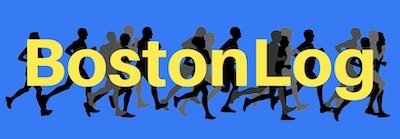“Against the wind/ We were runnin’ against the wind/ We were young and strong, we were runnin’/ Against the wind…” -Bob Seger
My heart sank when I saw the weather forecast. It’s silly of course because the weather is something we cannot control (although the report did make me pack my warm Hoka hat, which in retrospect I’m very glad I did!), and to worry about it only made me unnecessarily cranky.
Anything but a headwind! I cringed at the thought of a cold and wet breeze hampering my pace. Thinking back to my short lived days as an aspiring mechanical/aerospace engineering student at Cornell, I remember calculating drag coefficients and how wind speed resulted in exponential relations. In other words, the faster you go, the more of an influence wind has, at an alarmingly increasing rate.
Running close to 5min/mile pace (12mph), straight into a (projected) 13 mph headwind would result in what would feel like a 25mph wind! Any other day that entire week in Boston would’ve been a “faster” day to run the marathon!
The “weather excuse” played out over and over in my mind in the final few days leading into Marathon Monday. I became quite discouraged and spiraled into a negative thought cycle.
But the night before the race I had to pinch myself. I had to remind myself I was still in Boston, to run my very best race possible, and also place as well as possible. It appeared going for an Olympic Trials marathon time (sub 2:18:00) was going to be a long shot goal if the wind was blowing head-on at over 10-15mph for most of the race. I decided the only thing to do was “play it by ear.” I’d have to respond to weather and how I felt on the fly… I had to be flexible to execute my ideal race.
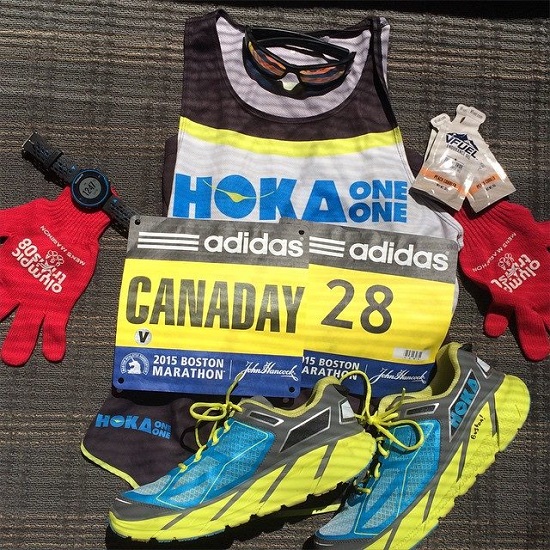
Knowing from my prior Boston experience (ironically an epic blow-up on a perfect weather conditions day in 2010, when I wasn’t coaching myself), things really start to get real in the Newton hills. Actually in any marathon things get real around mile 20, as how I feel there (usually on the edge of blowing a gasket, if it hasn’t happened already) usually determines whether or not the race is going to be an epic melt-down or a “slow fade into the wall” (the latter of course being much more of an ideal race with relatively even mile splits). I could only wait and see based on my sensory data and prior knowledge what kind of pace I might be able to sustain when I reached that point on the course.
Hope. I felt hope right before the start in Hopkinton. There was news that perhaps the wind and rain was coming in a bit later in the day.
“Perhaps I could beat the headwind at least to the Newton hills,” I thought to myself, gaining confidence my goal of averaging 5:15 mile pace for an Olympic Trials Qualifying time could still be attainable!
Standing on the starting line right behind last year’s champion Meb Keflezighi, there was a sense of calm. The rain hadn’t started yet and I didn’t feel too much wind. It was on…
I was going for an OTQ time!
While the leaders shot off the line at 4:30/mile pace, I sat back in about 30th place, coasting through the first very downhill mile in 5:00. I joked with one of the guys next to me I hoped it wasn’t our fastest mile split of the day, while knowing deep down inside it was very likely going to be!
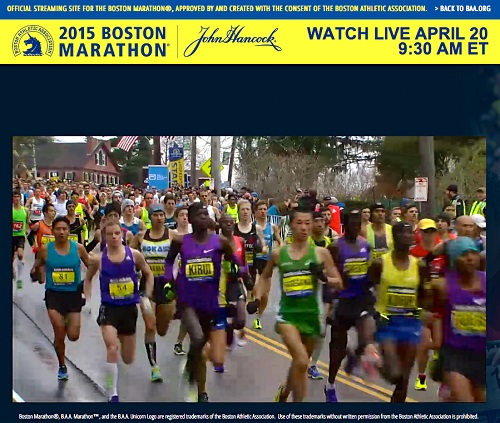
As we settled in for the first 5km or so (16:08), a large gap formed between us and the real elite lead pack. I got antsy with the mile splits, as running in a pack with 20 or so guys seemed to be inconsistent, and things started to slow down. We had some 5:18 and 5:20-ish mile splits in there. I figured with the substantial downhills early on, 5:10s would be much better to hit to even have a shot at a sub 2:18:00 OTQ.
I briefly told some of the guys I’d like to try to come through halfway in a low 1:08. A couple of these runners already had trials qualifiers though, and they were more interested in place. After that, talking pretty much ceased as I was breathing pretty hard already!
I was put in a tough position, trying to force a run for a time in a group that was (very understandably, given the wind) much more interested in place. Coming through ten miles in about 52:20, I was just under 2:18 pace and starting to notice the wind. I had a critical choice to make: 1) Forge forward solo into the wind and try to catch a “pack” of two guys I saw about 300 meters in front of me, or 2) Sit back with a “safer pack” of 15 or so guys who could help shelter some of the burden from the wind.
I went with my first choice and I’m glad I did, as it ended up being my most decisive move of the entire race. Leaning into the wind as the course opened up heading towards Wellesley, I recorded my halfway split at 1:08:38. About exactly what I wanted, but it didn’t feel very good! The noticeable gusts of wind bothered me and I ran solo (with gaps of about 200m both in front and behind me) for the next five miles towards Newton.
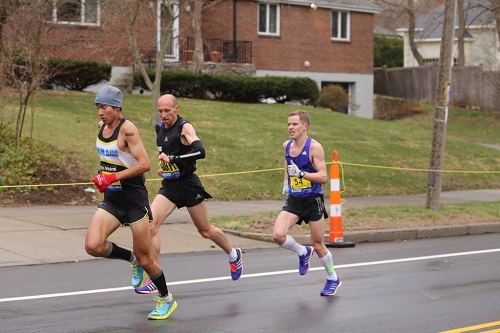
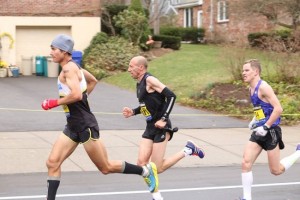
Coming into the infamous Newton Hills, I finally caught two foreign runners Danilo Goffi (a former 2:08 marathoner who placed ninth at the Olympic Games in 1996, but was now competing as a 42-year old masters runner for Italy!) and Sergey Zyryanov (I couldn’t find much about him, but he was from Russia and ran really tough!). As we tackled the Newton hills, Danilo would amazingly surge on the uphills and gap us, while Sergey would come flying back on the downhills. It was a free-for-all competition for place at this point, so helping each other with drafting against the wind wasn’t really happening all that much!
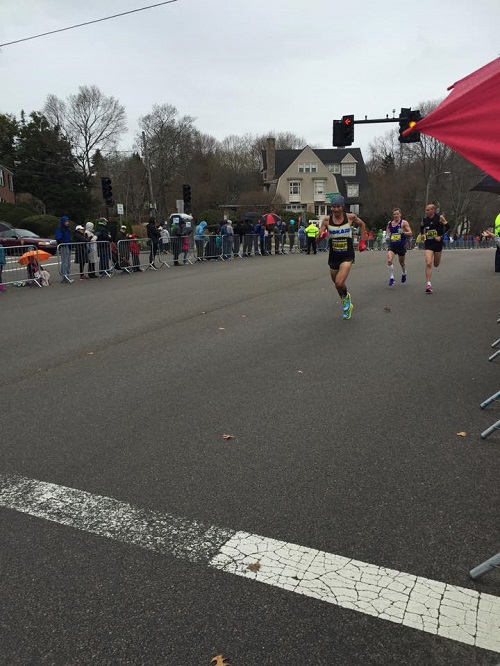
Near Heartbreak Hill at Mile 20, I felt my time goal slipping away, as I thrashed my arms to get my stiff legs moving. My stride rate slowed. The cold wind and rain pounded us as the threat of cramping, hypoglycemia, and hypothermia sunk in. Pain clenched my entire body like a vice clamp slowly tightening its tortuous grip. As I popped my fourth Vfuel gel, I tried to regain mental focus as my body was starting to crumble. I thought about how funny it was I was still wearing my warm HOKA hat. I had never warmed up enough to chuck it to the crowd, as I assumed I would’ve much earlier!
1:45:10. I came through 20 miles exactly ten seconds off my goal pace. It was the first time I had been behind pace all day and I had a gut feeling that getting back ahead of pace was likely not going to be a reality in the last 10km of the race. My legs were on edge, and despite running a bit with Danilo and Sergey, the wind was making 5:20 miles feel wickedly hard.
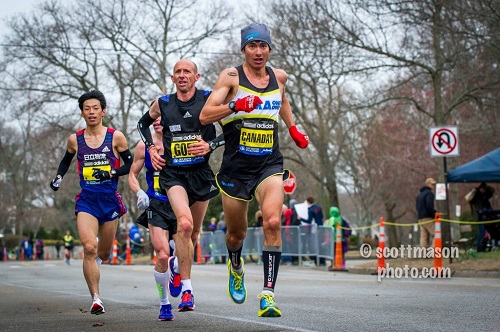
Over the final miles we moved up in place as many from the lead pack had seemingly dropped out. I had no idea what place I was in until about mile 23 when a spectator yelled out I was in 16th. By then, Danilo had pulled away convincingly and Sergey was right behind me. We ended up finishing exactly in that order.
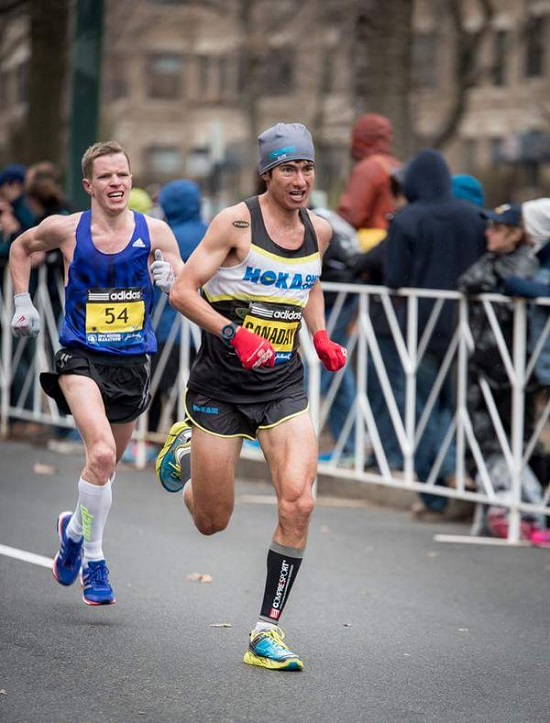

After mustering up a weak kick I finally finished in 2:19:12. 72 seconds off my goal, but in 16th place overall.
I admit it was a little bittersweet to miss my goal of qualifying for the US Olympic Trials for the second time in six weeks. But in hindsight, my experience in Boston was very positive. It was my best placing in a world marathon majors race (besting my 17th place at Chicago in 2010), and a much better improvement from my prior Boston performance (a 2:24 on a perfect weather day in 2010 where I totally blew a gasket).
I ran the race I wanted in terms of strategy, tactics and pacing; and the effort wasn’t a horrible positive split or complete bonk, like many of my marathons have been. I went for it, held nothing back, and came up just a little bit short…
Sage Canaday
Boulder, Colorado
April 20, 2015
Age – 29
Bib # 28
2:19:12
[Oregon native Sage Canaday ran for Newberg High School and placed 13th in the state cross country meet his senior year. Determined to run DI in college, he traveled across the country to run for Robert Johnson at Cornell University. At Cornell, Sage not only qualified for the 2008 US Olympic trials marathon (where he was the youngest competitor), he also won the Ivy League Conference title for 10,000m on the track and qualified as an individual for the 2007 NCAA Championships in cross country.
In the spring of 2012 Sage started ultra marathons and trail running. Follow this Mountain-Ultra-Trail Runner on Facebook (Sage Canaday/ Athlete) or on his website sagecanaday.com ]
